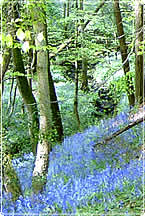Management Conservation
- Conservation involves a high degree of management and valuable habitats cannot simply be left to look after themselves.
- If grassland is not managed, it will soon change into scrub and then woodland by the process of succession, and the very species that were being protected will disappear.
- Management involves a blend of actions designed to encourage particular species and a policy of non-intervention or disturbance.
- Each habitat type will have a set of guidelines for conservationists to follow although a management plan will always involve a process of careful planning. This is shown in the diagram above right.
Management of broad-leaved woodland.
Woodland management involves a wide range of options and might include some or all of the following:
 Planting: it is usually desirable to plant a mixture of broad-leaved species which will encourage a wide range of species.
Planting: it is usually desirable to plant a mixture of broad-leaved species which will encourage a wide range of species.- Coppicing: this involves a cutting cycle of 5-25 years depending on the species involved. Hazel coppice has a cycle of 6-10 years and involves cutting down to ground level mature hazel and then letting it grow back to its 10 year old height. As the coppice grows it provides a succession of different habitats for a wide range of different woodland organisms. One hazel unit is known as a ‘coppice stool’. Some of the woodland is divided up into different compartments with a different age stand in each.
- Natural regeneration: where woodland has been felled, woodland will regenerate naturally, seeding from mature woodland nearby. The species which move in will be well adapted to local conditions.
- Ride and glade maintenance: the creation and maintenance of broad rides and glades provide an ‘edge of woodland’ habitat for a wide range of organisms. Grass height can be tiered from the edge to the middle but cut grass will need to be taken away to keep nutrient levels low, which is essential for most wild flowers. Rides are particularly good at encouraging butterflies.
- Grazing control: it can often be useful to allow some controlled grazing in selected areas of the woodland. This can increase local biodiversity, possibly mimicking the type of grazing that used to happen in ancient forests e.g. wild boars.
- Clearing dead wood: Standing and fallen wood does provide useful habits for insects and birds. Sometimes excess wood will need to be cleared for amenity or access reasons. Some may also be sold to bring in revenue.
- Removing undesirable species: invasive species, such as rhododendron, will need to be removed.
- Managing the understorey: this shrub layer is important for a high biodiversity. Invasive species, such as sycamore, cast dense shade and extract valuable water. These need to be removed and replaced with native species such as hawthorn and bramble. These species provide valuable food for other woodland organisms.
- Managing the woodland edge: the woodland edge is an important habitat for many species. This edge will also develop a dense understory layer which can be useful as a natural barrier for the woodland and controlling public access.
- Archaeological features: many ancient woodlands will have features from the past, such as boundaries, coppiced areas and lime kilns. These can be managed to enhance interest in the woodland.
 Restoration Conservation
Restoration Conservation

What's your opinion?
Average rating




Not yet rated